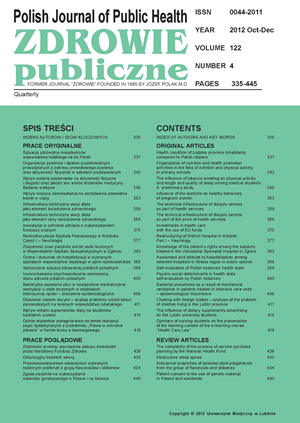Restructuring of District Hospital in Kraśnik. Part I – Neurology
DOI:
https://doi.org/10.12923/j.0044-2011/122-4/a.08Keywords:
neurological department, stroke unit, neurological rehabilitation, autonomous public healthcare institution, restructuringAbstract
Introduction. Analysis of functioning of the Independent Public Healthcare Centre in Kraśnik led to the decision on the deep restructuring of this institution. One of departments, in which the annual cost was bigger than the income was Neurological Department. Far-reaching changes in hospital activity were introduced by enlarging this medical ward, establishing the stroke sub-unit and the Department of the Neurological Rehabilitation.
Aim. The research aimed at demonstrating the relation between the restructuring of the Neurological Ward, and the size of the contract with the National Health Fund. Additionally establishing the relationship between the conducted restructuring, and changes of the value of such indicators as: the number of man-days, the cost of the man-day, the number of the hospitalizations, the cost of the hospitalization and the income and costs of the analysed unit were additional goals.
Material and methods. The research covered 2006-2012.Values of agreements with the National Health Fund were analysed in hospital treatment in neurology and in rehabilitation in the scope of neurological rehabilitation. Numbers of man-days and the hospitalization, as well as a value of the cost of both the income of the man-day and the hospitalization were examined.
Results. Scores of benefits entered in agreements in the type of the hospital treatment from 2006 constantly expands and in the course of six years it grew by about 78.82%.at that time also three-fold increase in the amount of funds from National Health Fund for stationary treatment of neurological patients was obtained.
Conclusions. The restructuring of the neurological ward produced the desired effect in the form of exercising considerably substantial amount of neurological benefits, both in the type hospital treatment, as well as in the type of rehabilitation. The action improved the accessibility to benefits of the health care of the neurological profile, as well as caused the complexity of these benefits.
References
1. Ustawa z dnia 15 kwietnia 2011 r. o działalności leczniczej (Dz. U. 2011 nr 112 poz. 654 z późn. zm.).
2. Dercz M, Rek T. Podstawy prawne finansowania świadczeń zdrowotnych przez podmioty publiczne – zarys problematyki. Zeszyty naukowe Ochrony Zdrowia. Zdr Publ i Zarządz. 2005;3(1).
3. Ustawa z dnia 5 czerwca 1998 r. o samorządzie powiatowym (Dz. U. 1998 nr 91 poz. 578 z późn. zm.).
4. Furtak M, Książek P, Warchoł-Sławińska E. Proces podejmowania decyzji w sektorze ochrony zdrowia. Zdr Publ. 2011;121(3):228-33.
5. Cichońska D, Iltchev P. Zarządzanie ryzykiem w zakładach opieki zdrowotnej. Zdr Publ. 2011;121(1):3-7.
6. Sarzyńska-Długosz I. Oddziały udarowe – zadania i organizacja. Pol Przegl Neurol. 2008;4(suppl. A):16-7.
7. Grupa Ekspertów NPPiLUM: Rekomendacje Grupy Ekspertów Narodowego Programu Profilaktyki i Leczenia Udaru Mózgu. Organizacja pododdziałów udarowych. Neurologia i Neurochirurgia Pol. 2003;2:3102-9.
8. Miller E. Rola pielęgniarki w rehabilitacji i opiece nad chorymi po udarze mózgu. Problemy Pielęgniarstwa. 2009;17(9):152-6.
9. Sarzyńska-Długosz I, Krawczyk M. Ocena dostępności wczesnej kompleksowej rehabilitacji poudarowej w Polsce. Neurologia i Neurochirurgia Pol. 2006;40(1):10-5.
10. Pytel A, Wrzosek Z. Cele kompleksowej rehabilitacji w ostrym okresie udaru mózgu. Balneologia Pol. 2009;51(2):81-6.


